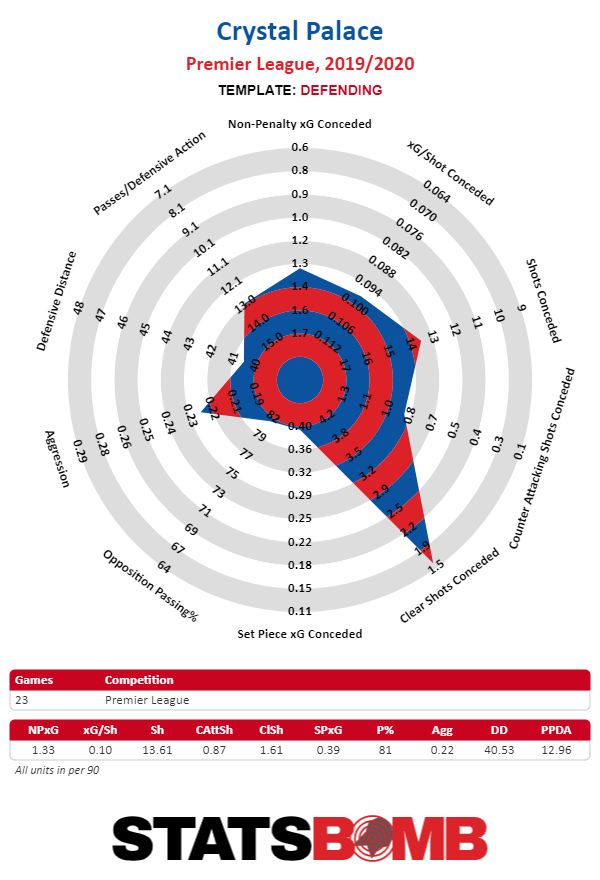Crystal Palace are a wonder to behold. They are by any particular measure an absolutely terrible team. And yet, 23 games into the Premier League season, they sit comfortably at ninth place in the table. It’s always tempting to look for reasons why in cases like Palace. Surely, the numbers must be missing something. And yet, as seductive as the siren call of pattern recognition might be to the human brain, sometimes there’s no greater answer than that the soccer gods are really enamored with Roy Hodgson. You don’t need fancy stats to understand that Crystal Palace are an anemic attacking side. They’ve scored only 22 goals this season. Only relegation battlers Watford and Bournemouth have scored fewer. That scoring record is a fair reflection of their underlying performance. They’ve scored 19 non-penalty goals and have 19.10 expected goals. Their xG per match of 0.82 is only narrowly edged out by Newcastle’s 0.81 for the lowest in the league. 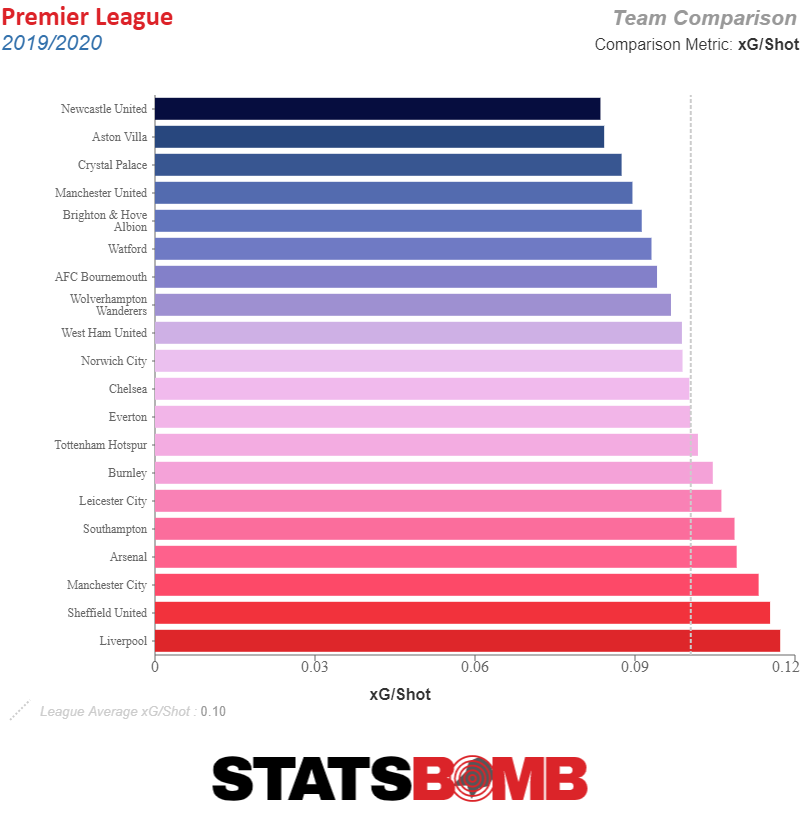 The problems are obvious. Palace only takes 9.39 shots per match, the fewest in the league. Those shots are themselves valued at only 0.09 xG per shot, the third-worst average in the league. So, to paraphrase Yogi Berra: The shots here are terrible and there are so few of them. That’s simply a recipe for attacking futility any way you slice it.
The problems are obvious. Palace only takes 9.39 shots per match, the fewest in the league. Those shots are themselves valued at only 0.09 xG per shot, the third-worst average in the league. So, to paraphrase Yogi Berra: The shots here are terrible and there are so few of them. That’s simply a recipe for attacking futility any way you slice it. 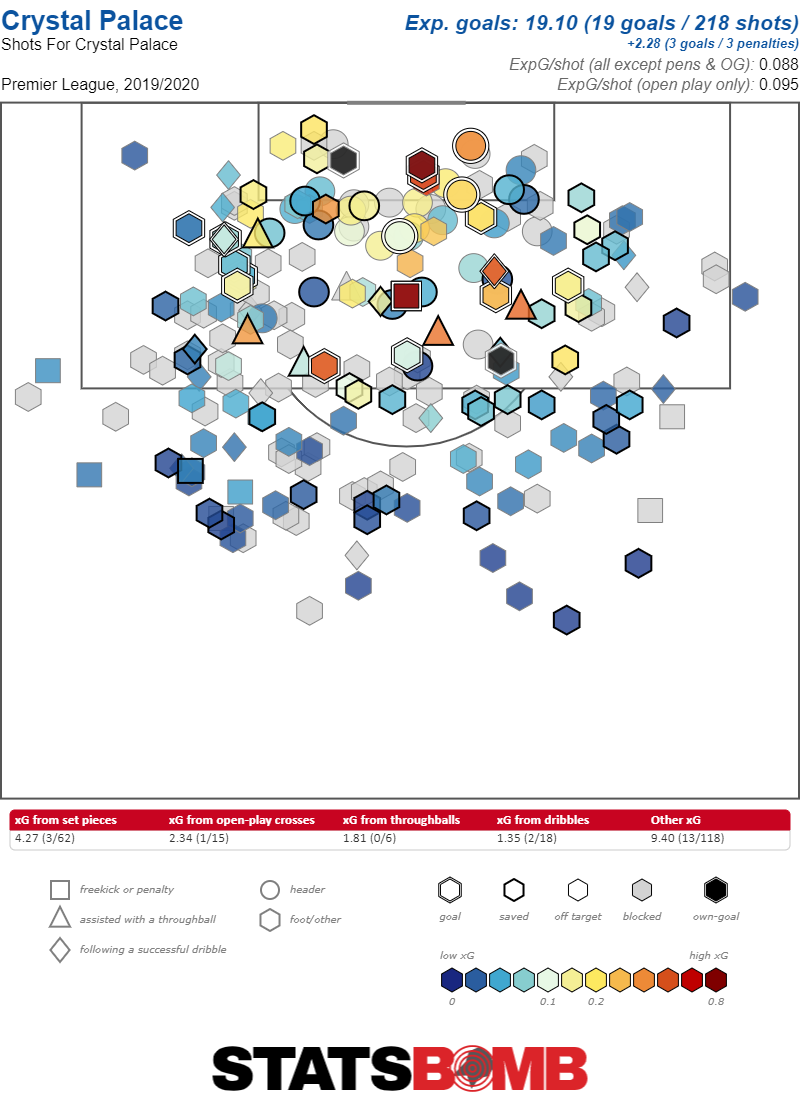 But wait, I hear you cry, surely their defense must be their calling card. Many a successful season has been built on a pathetic attack married to a stalwart, death-defying defense. And it’s true that, at least superficially, Palace is stronger on that side of the ball. They’ve only conceded 26 goals; that’s a great number. Only Liverpool, Leicester City and Sheffield United have conceded fewer. Wow! But here the advanced numbers are a little more useful. Crystal Palace give up a lot of shots. They concede 13.61 per match; only Aston Villa, Newcastle, Norwich, Arsenal and Bournemouth give up more. To their credit, those shots have been largely benign. The average xG per shot of those Palace have conceded is 0.10, a mark only bettered by Wolverhampton, Arsenal, Burnley, Tottenham Hotspur, Norwich City and Manchester United. Lots of shots conceded, but mostly bad shots can be a recipe for an acceptable defense, and that’s exactly what Palace have. Hodgson has his team playing as the 13th best defense in the Premier League with a non-penalty xG conceded per game of 1.33. Of course, that’s a far cry from having conceded the fourth-fewest goals in the Premier League. Enter Vincente Guaita. Want one weird trick for turning your somewhat below-average defensive side into the fourth-best in the league? Have your keeper play absolutely out of his gosh-darned mind. Guaita is single-handedly responsible for saving just below eight goals more than a keeper putting in an average performance might have this season. Add those goals back in and a Palace side that conceded 34 goals would be much less notable. They would, In fact, be awfully close to where xG predicts, with only five teams conceding more than them, and three others conceding the exact same amount.
But wait, I hear you cry, surely their defense must be their calling card. Many a successful season has been built on a pathetic attack married to a stalwart, death-defying defense. And it’s true that, at least superficially, Palace is stronger on that side of the ball. They’ve only conceded 26 goals; that’s a great number. Only Liverpool, Leicester City and Sheffield United have conceded fewer. Wow! But here the advanced numbers are a little more useful. Crystal Palace give up a lot of shots. They concede 13.61 per match; only Aston Villa, Newcastle, Norwich, Arsenal and Bournemouth give up more. To their credit, those shots have been largely benign. The average xG per shot of those Palace have conceded is 0.10, a mark only bettered by Wolverhampton, Arsenal, Burnley, Tottenham Hotspur, Norwich City and Manchester United. Lots of shots conceded, but mostly bad shots can be a recipe for an acceptable defense, and that’s exactly what Palace have. Hodgson has his team playing as the 13th best defense in the Premier League with a non-penalty xG conceded per game of 1.33. Of course, that’s a far cry from having conceded the fourth-fewest goals in the Premier League. Enter Vincente Guaita. Want one weird trick for turning your somewhat below-average defensive side into the fourth-best in the league? Have your keeper play absolutely out of his gosh-darned mind. Guaita is single-handedly responsible for saving just below eight goals more than a keeper putting in an average performance might have this season. Add those goals back in and a Palace side that conceded 34 goals would be much less notable. They would, In fact, be awfully close to where xG predicts, with only five teams conceding more than them, and three others conceding the exact same amount. 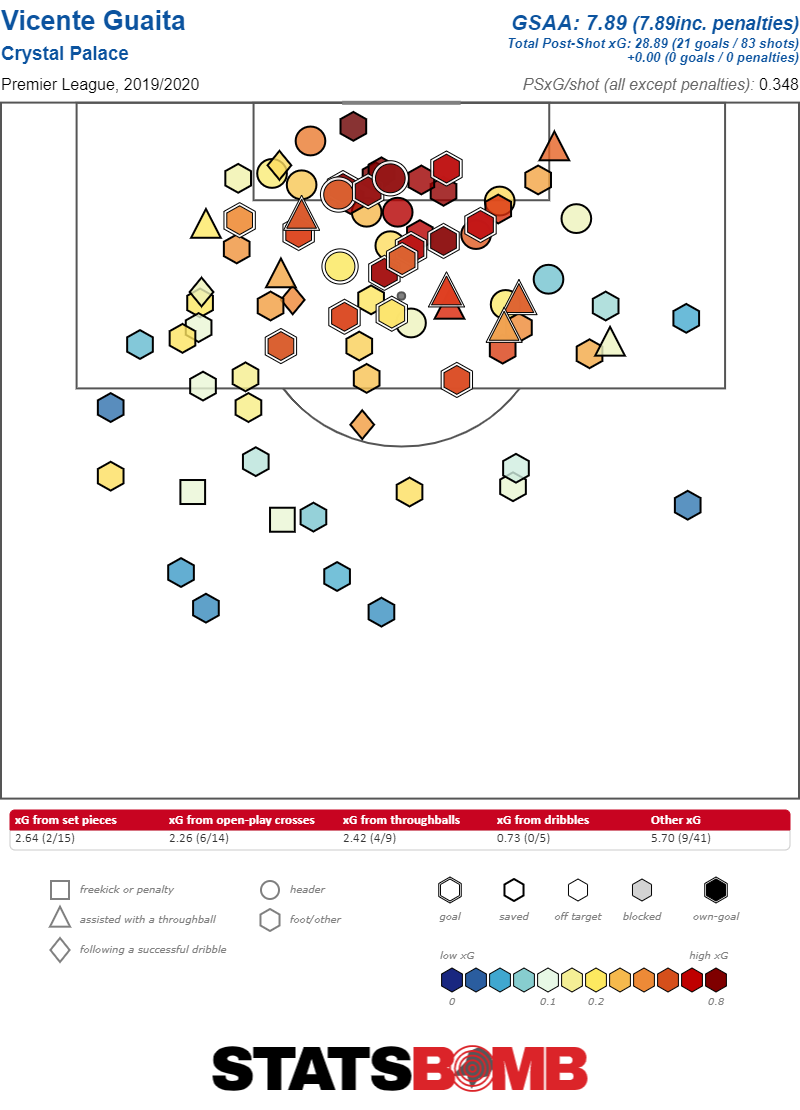 Clearly you don’t need advanced stats to understand how good Guaita’s been. He plays for Palace and Palace have been the fourth-stingiest team in the league defensively, which alone is a pretty wonderful advert for him. But those fancy numbers make it even clearer. Guaita’s save percentage isn’t all that impressive. At 74.7%, there are five other keepers ahead of him, so he's good but not exceptional. What really makes him pop, though, is that he’s faced an exceptionally difficult caliber of shot. In fact, given the shots he’s faced, an average keeper would only be expected to save 65.2% of them. He’s faced the third-hardest set of shots in the league, which puts the fact that he has the sixth-highest save percentage in an entirely different light. There is nobody in the Premier League with a larger difference between their save percentage and expected save percentage than Guaita. That’s the purest measure of how good a shot stopper a keeper has been. The 9.5% difference puts him ever so slightly ahead of Liverpool’s Alisson as the keeper who has been the best this year at keeping the ball out of the net relative to expectations. The problem for Crystal Palace is that there’s nothing that suggests Guaita’s remarkable season will continue. At 33 years old, the Spaniard has had a solid career, first with Valencia, then over four years with Getafe, before landing in London, but nothing that suggests the spectacular. Last year, his first with Crystal Palace, he was fine. Ironically, he had a very similar save percentage, 74.4%, but shots he faced were considerably easier, and had an expected save percentage of 72.2%. So, he was 2.2% better than expected in his time on the field—nothing to sneeze at, but a far cry from 9.5%.
Clearly you don’t need advanced stats to understand how good Guaita’s been. He plays for Palace and Palace have been the fourth-stingiest team in the league defensively, which alone is a pretty wonderful advert for him. But those fancy numbers make it even clearer. Guaita’s save percentage isn’t all that impressive. At 74.7%, there are five other keepers ahead of him, so he's good but not exceptional. What really makes him pop, though, is that he’s faced an exceptionally difficult caliber of shot. In fact, given the shots he’s faced, an average keeper would only be expected to save 65.2% of them. He’s faced the third-hardest set of shots in the league, which puts the fact that he has the sixth-highest save percentage in an entirely different light. There is nobody in the Premier League with a larger difference between their save percentage and expected save percentage than Guaita. That’s the purest measure of how good a shot stopper a keeper has been. The 9.5% difference puts him ever so slightly ahead of Liverpool’s Alisson as the keeper who has been the best this year at keeping the ball out of the net relative to expectations. The problem for Crystal Palace is that there’s nothing that suggests Guaita’s remarkable season will continue. At 33 years old, the Spaniard has had a solid career, first with Valencia, then over four years with Getafe, before landing in London, but nothing that suggests the spectacular. Last year, his first with Crystal Palace, he was fine. Ironically, he had a very similar save percentage, 74.4%, but shots he faced were considerably easier, and had an expected save percentage of 72.2%. So, he was 2.2% better than expected in his time on the field—nothing to sneeze at, but a far cry from 9.5%. 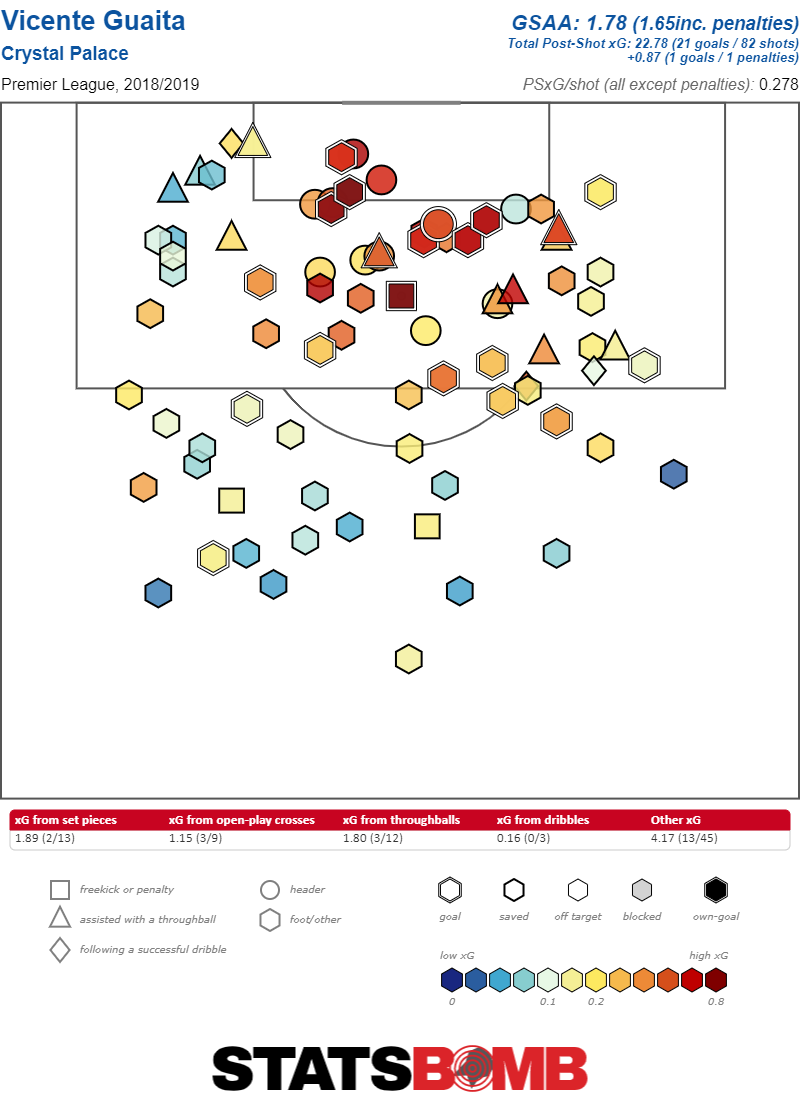 All of which is to say that the miracle of Crystal Palace stems primarily from their keeper, and their keeper, despite a long history of being pretty good, does not have a history of being miraculous. Sometimes it’s hard to pinpoint where and how the soccer gods are sprinkling their dust. Other times they just straight-up inhabit the body of a journeyman 33-year-old keeper. None of this should be particularly encouraging for Crystal Palace supporters, however. It’s great that Guaita sprouted tree trunk arms for twenty games, which was almost single-handedly enough to push them from relegation battlers to the top half of the Premier League table. Barring an absolutely astounding collapse they’ll remain in the top division to fight another season. But this doesn’t bode well for their long-term health. When those fickle gods alight upon somebody else’s body, Crystal Palace will be left with an anemic attack and a defense that isn’t nearly as strong as Guaita’s form has made it seem. That may not matter this season, but if they don’t figure out how to get better before the next, a relegation battle awaits. And there, but for the soccer gods, will go Crystal Palace.
All of which is to say that the miracle of Crystal Palace stems primarily from their keeper, and their keeper, despite a long history of being pretty good, does not have a history of being miraculous. Sometimes it’s hard to pinpoint where and how the soccer gods are sprinkling their dust. Other times they just straight-up inhabit the body of a journeyman 33-year-old keeper. None of this should be particularly encouraging for Crystal Palace supporters, however. It’s great that Guaita sprouted tree trunk arms for twenty games, which was almost single-handedly enough to push them from relegation battlers to the top half of the Premier League table. Barring an absolutely astounding collapse they’ll remain in the top division to fight another season. But this doesn’t bode well for their long-term health. When those fickle gods alight upon somebody else’s body, Crystal Palace will be left with an anemic attack and a defense that isn’t nearly as strong as Guaita’s form has made it seem. That may not matter this season, but if they don’t figure out how to get better before the next, a relegation battle awaits. And there, but for the soccer gods, will go Crystal Palace.
2020
Who saved Crystal Palace's season?
By Kevin Lawson
|
January 21, 2020
